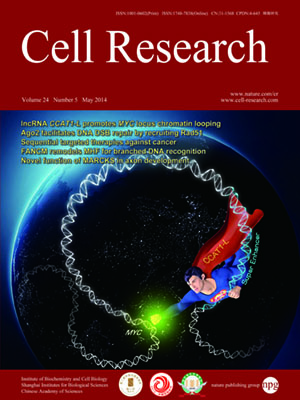
Volume 24, No 5, May 2014
ISSN: 1001-0602
EISSN: 1748-7838 2018
impact factor 17.848*
(Clarivate Analytics, 2019)
Volume 24 Issue 5, May 2014: 532-541 | Open Access
ORIGINAL ARTICLES
Ago2 facilitates Rad51 recruitment and DNA double-strand break repair by homologous recombination
Min Gao1,4, Wei Wei2,3, Ming-Ming Li1,4, Yong-Sheng Wu1, Zhaoqing Ba2,3, Kang-Xuan Jin1,4, Miao-Miao Li1,4, You-Qi Liao1,4, Samir Adhikari1,4, Zechen Chong1, Ting Zhang1, Cai-Xia Guo1, Tie-shan Tang5, Bing-Tao Zhu6, Xing-Zhi Xu6, Niels Mailand7, Yun-Gui Yang1,4, Yijun Qi2,3 and Jannie M Rendtlew Danielsen1,7
1Laboratory of Genome Variations and Precision Biomedicine, Beijing Institute of Genomics, Chinese Academy of Sciences, Beijing 100101, China
2Tsinghua-Peking Center for Life Sciences, Beijing 100084, China
3Center for Plant Biology, School of Life Sciences, Tsinghua University, Beijing 100084, China
4University of Chinese Academy of Sciences, Beijing 100049, China
5State Key Laboratory of Biomembrane and Membrane Biotechnology, Institute of Zoology, Chinese Academy of Sciences, Beijing 100101, China
6Beijing Key Laboratory of DNA Damage Response, College of Life Sciences, Capital Normal University, Beijing 100048, China
7The Novo Nordisk Foundation Center for Protein Research, Ubiquitin Signalling Group, Faculty of Health Sciences, Copenhagen, Denmark
Correspondence: Yijun Qi, E-mail: qiyijun@tsinghua.edu.cn; Yun-Gui Yang(ygyang@big.ac.cn)
DNA double-strand breaks (DSBs) are highly cytotoxic lesions and pose a major threat to genome stability if not properly repaired. We and others have previously shown that a class of DSB-induced small RNAs (diRNAs) is produced from sequences around DSB sites. DiRNAs are associated with Argonaute (Ago) proteins and play an important role in DSB repair, though the mechanism through which they act remains unclear. Here, we report that the role of diRNAs in DSB repair is restricted to repair by homologous recombination (HR) and that it specifically relies on the effector protein Ago2 in mammalian cells. Interestingly, we show that Ago2 forms a complex with Rad51 and that the interaction is enhanced in cells treated with ionizing radiation. We demonstrate that Rad51 accumulation at DSB sites and HR repair depend on catalytic activity and small RNA-binding capability of Ago2. In contrast, DSB resection as well as RPA and Mre11 loading is unaffected by Ago2 or Dicer depletion, suggesting that Ago2 very likely functions directly in mediating Rad51 accumulation at DSBs. Taken together, our findings suggest that guided by diRNAs, Ago2 can promote Rad51 recruitment and/or retention at DSBs to facilitate repair by HR.
10.1038/cr.2014.36
FULL TEXT | PDF
Browse 3017


